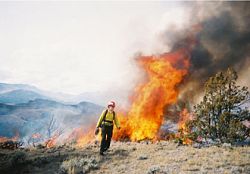Fire fighter protects alma mater from destruction

SALT LAKE CITY — Sarah Evans never realized when she was a student at St. Joseph Catholic High School in Ogden that one day she would be fighting to save it from a threatening fire. "My daughter was called to respond to the brush fire at St. Joseph Catholic High School as a member of the U.S. Forest Service Wild Land Fire fighting crew," said her father, Steven Evans, in an e-mail to the Intermountain Catholic June 5. "She drives a pumper stationed at the mouth of Big Cottonwood Canyon. Her pumper (engine) was located just east of the Lew Joseph Soccer field, providing water to prevent the fire from moving west into the adjacent residential area and the St. Joseph High School campus. "Sarah attended St. Joseph Catholic Schools from kindergarten through 12th grade," said Steve. "She graduated with the St. Joseph High School class of 1995. She was defending her alma mater. Last year, she and her pumper crew also responded to the fire that threatened the area just above St. James Catholic Church, which was her home parish while growing up in Ogden." "Fighting the fire behind the school was definitely weird because we were on the pipe line road right behind the soccer field, which I used to run on for cross country," said Sarah, in an interview with the Intermountain Catholic. "It wasn’t a large or extreme fire, but we had several engines there. I think they decided it was human caused, but I don’t think they ever found who caused the fire. It was just kind of nostalgic almost to be there doing what I am doing now and loving it, but having it be in the backyard of my high school." Sarah became interested in fighting fires when she was 20 years old. "My friends and I came down to Salt Lake City to a free Concert in the Park, by the old Capital Theater. We parked the car, and when we walked out, the building across the street was on fire. My girlfriend and I were mesmerized, and we watched the whole process with all the fire trucks and engines. We did not even make it to the concert. She and I just sat there and watched it the whole time. One of the fire captains from one of the engines came over. She was female, and she had seen us there the whole time. She started talking to us and invited us down to her station. That really gave me the bug. That was a structural fire though, and structural fire fighting is a little more difficult to get into than wild land fire fighting because there are so many people who want to get into that profession. "I knew people who fought wild land fires, so I thought maybe I could get my feet wet with that first and see where led me," said Sarah. It was a few years after she witnessed the fire on her way to the concert that she accepted a job in recreation with the Shoshone National Forest in Cody, Wyo. This was seasonal work, but she accepted it just to get her foot in the door. Sarah had been attending the University of Utah to become an athletic trainer. She had applied for wild land fires in Utah and had not been accepted. Taking the job in recreation allowed her to meet the fire fighters in Wyoming. Sarah worked one season on fires in Wyoming before coming to the Salt Lake Ranger District for the Wasatch Cache National Forest. She has been there for the last three seasons, which lasts from May to October. Sarah enjoys the outdoors, and says she has to because she sleeps in the dirt and eats in the dirt or the sagebrush. Sometimes you go a week or two without a shower. "I always enjoyed camping when I was a kid," said Sarah. "But this is a little more hard core; it is a way of living. When you go to the really big fires and they have the large fire camps, it is almost like a little city. When you are on those little initial attack type fires and it is four or five crew members, you eat government packaged meals ready to eat or MRE’s, cans that are about 3,500 calories. The same meals service men and women eat." Sarah said to qualify for wild land fires you have to physically pass the pack test, which is three miles in 45 minutes with a 45 pound pack on your back. You have to take week-long fire camp classes each year that give you basic knowledge as a trainee in things like fire behavior, weather, topography, fuel, the incident command system, how to use different tools, and personal protection equipment. "In fighting the fires, the largest hose we carry is 100 feet in length and an inch and a half in diameter," said Sarah. "Water still gets heavy, but it is not massive as we weave and maneuver through trees and oak brush, or protect a radio tower in the desert. In wild land fires you try hard not to breathe in the smoke, but that is somewhat impossible."
© Copyright 2024 The Diocese of Salt Lake City. All rights reserved.

Stay Connected With Us